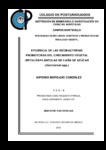| dc.description.abstract | Las Rizobacterias Promotoras de Crecimiento Vegetal (RPCV) son una alternativa en la nutrición de plantas cultivadas, ya que estimulan su crecimiento y rendimiento, mejorando la absorción de nutrimentos, el aumento en su movilización, la producción de antibióticos y de reguladores de crecimiento. La caña de azúcar (Saccharum spp.) es un cultivo muy demandante de nutrimentos y de alto rendimiento en México, el uso de las RPCV es fundamental para mejorar su rentabilidad. En esta investigación, se evaluó la efectividad en producción de índoles totales por el método Salkowski, solubilización de fosfatos con medio Pikovskaya de 24 cepas bacterianas de siete especies, y su impacto en el desarrollo de vitroplantas de caña de azúcar de la variedad Mex 69-290 al ser inoculadas. Las cepas fueron previamente identificadas, en el Laboratorio de Interacción Molecular Planta-Microorganismo del Colegio de Postgraduados, las especies utilizadas fueron Aeromonas salmonicida, Burkholderia cepacia, Ochrobactrum anthropi, Pseudomonas sp., Shewanella putrefaciens, Sphingomonas paucimobilis, y se propagaron en caldo nutritivo. Esta investigación se encuentra adscrita a la Línea Prioritaria de Investigación 5 (LPI) del Colegio de Postgraduados. La unidad experimental fue una maceta con una mezcla esterilizada con 50% de suelo agrícola y 50% de agrolita, con una plántula de caña de azúcar producida in vitro. Se inoculó 1.0 mL de cultivo bacteriano (1X107 UFC) por maceta. El experimento se desarrolló en invernadero por 90 días, en un diseño experimental completamente al azar, con 24 tratamientos, un testigo y cinco repeticiones. Se realizaron cinco muestreos destructivos quincenales para medir las variables respuesta: altura, diámetro de tallo, número de macollos, área foliar, biomasa seca de la parte aérea y de la raíz. La especie Ochrobactrum anthropi fue superior en producción de indoles con valores de 116.69 y 115.70 µg mL-1 así como Pseudomonas luteola con 117.35 µg mL-1. En relación a la solubilización de fosfatos, Stenotrophomonas maltophilia presentó los valores más altos: 222.43 y 216.38 µg mL-1. Del total de cepas inoculadas, 13 fueron superiores en diferentes variables respuesta. La altura se incrementó en 27.75% en promedio con respecto al testigo, el diámetro en 30.75%, el número de macollos en 38.5%, el área foliar en 49%, el peso de materia seca aérea y de raíz en 50.75 y 59.5% respectivamente. En cuanto al índice de área foliar (IAF), tasa de asimilación neta (TAN), tasa relativa y absoluta de crecimiento (TRC y TAC), P. luteola, P. fluorescens, Oanthropi y S. maltophilia fueron las cepas que mostraron mayores efectos positivos. Las cepas P. luteola (Tratamiento 1), O. anthropi (T5), Aeromonas salmonicida (T15), Burkholderia cepacia (T16), P. fluorescens (T22) y S. maltophilia (T24) fueron las más destacadas en diferentes variables respuesta y su constante persistencia en el tiempo, siendo potenciales para ser utilizadas como biofertilizantes en el cultivo de caña de azúcar de forma individual o en consorcios, aunque son necesarios estudios de antibiosis para conocer la compatibilidad entre los microorganismos evaluados. _______________ EFFICIENCY OF PLANT GROWTH PROMOTING RHIZOBACTERIA (PGPR) ON SUGAR CANE (Saccharum spp.) PLANTLESS. ABSTRACT: Plant Growth Promoting Rhizobacteria (PGPR) are used as an alternative for nutrition of cultivated plants, since such bacteria are able to estimulate plant growth and yield, through processes such as nitrient uptake improvement, mineral movilization increase, biosíntesis of antibiotics and growth regulators. Sugar cane (Saccharum spp.) is a crop plant which demands high amount of nutrients and shows high yields in Mexico, therefore, the use of PGPR is crucial for improving its profits. In this research we evaluated the efficiency of production of total indols for Salkowski, phospahte solubility for Picovskaya method, of 24 bacterial strains belonging to seven different species, and its impact on sugar cane plantlets variety Mex 69-290 when being inoculated with such bacteria. Bacterial strains were previously characterized in the Laboratory of Plant-Microorganis Molecular Interaction from Colegio de Postgraduados, belonging to the species Aeromonas salmonicida, Burkholderia cepacia, Ochrobactrum anthropi, Pseudomonas sp., Shewanella putrefaciens, Sphingomonas paucimobilis and Stenotrophomonas maltophilia. Bacterial strains were propagated in a proper breeding ground. The experimental unit was a pot containing a sterile mixture of 50% crop soil and 50% agrolite, with a sugar cane plantless propagated in vitro. Each plant in the pot was inoculated with 1.0 mL of bacterial culture (1X107 UFC). The study was carried out in greenhouse during 90 days, using a completely randomized experiment with 24 treatments, a control, and five replicates each. After inoculation, five destructive samplings were performed every 15 days in order to measure response variables plant height, shoot diameter, number of stumps, foliar area, and dry biomass of shoot and roots. The species Ochrobactrum anthropi produced the highest amount of indols with values of 116.69 y 115.70 µg mL-1, as well as Pseudomonas luteola with 117.35 µg mL-1. Concerning phosphate solubilization, Stenotrophomonas maltophilia showed the highest values: 222.43 y 216.38 µg mL-1. From the total of bacterial strain inoculated, 13 showed superior effects on plant growth variables measured. Plant height increased 27.75% on average in comparison to the control; shoot diameter in 30.75%, number of stumps in 38.5%, foliar area in 49%, dry biomass of shoot and root 50.75 and 59.5%, respectively. In relation to foliar area index (IAF), net assimilation rate (TAN), relative and absolute growth rate (TRC and TAC), P. luteola, P. fluorescens, O. anthropi y S. maltophilia were the strains showing the strongest effects. The species P. luteola (Treatment 1), O. anthropi (T5), Aeromonas salmonicida (T15), Burkholderia cepacia (T16), P. fluorescens (T22) and S. maltophilia (T24) were the most prominent in different response variables and their permanence during the time of the experiment, and therefore can be used as biofertilizers in the sugar cane crop individually or associated, though studies on antibiosis in order to know compatibility strategies must be carried out in deep. | en_US |


